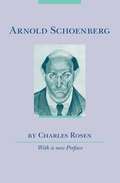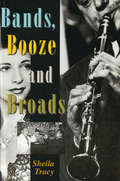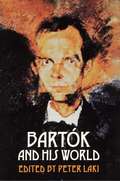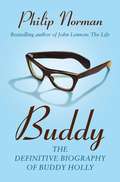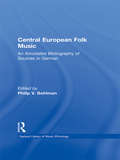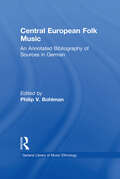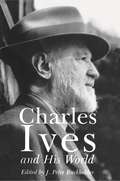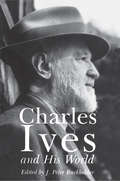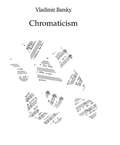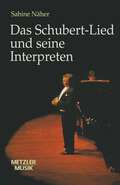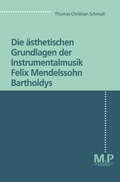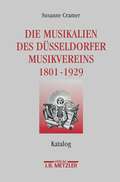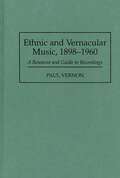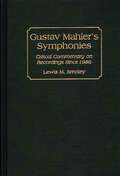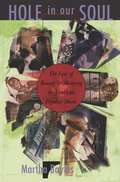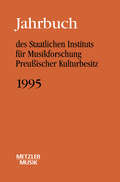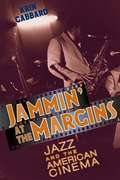- Table View
- List View
Arnold Schoenberg (Princeton Legacy Library)
by Charles RosenIn this lucid, revealing book, award-winning pianist and scholar Charles Rosen sheds light on the elusive music of Arnold Schoenberg and his challenge to conventional musical forms. Rosen argues that Schoenberg's music, with its atonality and dissonance, possesses a rare balance of form and emotion, making it, according to Rosen, "the most expressive music ever written." Concise and accessible, this book will appeal to fans, non-fans, and scholars of Schoenberg, and to those who have yet to be introduced to the works of one of the greatest composers of the twentieth century. "Arnold Schoenberg is one of the most brilliant monographs ever to be published on any composer, let alone the most difficult master of the present age. . . . Indispensable to anyone seeking to understand the crucial musical ideas of the first three decades."—Robert Craft, New York Review of Books "What Mr. Rosen does far better than one could reasonably expect in so concise a book is not only elucidate Schoenberg's composing techniques and artistic philosophy but to place them in history."—Donal Henahan, New York Times Book Review "For the novice and the knowledgeable, Mr. Rosen's book is very important reading, either as an introduction to the master or as a stimulus to rethinking our opinions of him. Mr. Rosen's accomplishment is enviable."—Joel Sachs, Musical Quarterly
Bach and the Patterns of Invention
by Laurence DreyfusIn this major new interpretation of the music of J. S. Bach, we gain a striking picture of the composer as a unique critic of his age. By reading Bach's music "against the grain" of contemporaries such as Vivaldi and Telemann, Laurence Dreyfus explains how Bach's approach to musical invention in a variety of genres posed a fundamental challenge to Baroque aesthetics.
Bands, Booze And Broads
by Sheila TracyIn this captivating study of one of our most popular music genres, Sheila Tracy goes behind the scenes and talks to over 60 Americans who played with the most famous big bands - and who lived to tell the tale. This was no mean feat: swing music''s huge popularity brought the performers wild adulation and, for many, resorting to drugs and alcohol was the only way to keep up. These musicians relate their incredible experiences of life on the road, where the pressure to party every night was enormous.
Bartók and His World (The Bard Music Festival #50)
by Peter LakiBéla Bartók, who died in New York fifty years ago this September, is one of the most frequently performed twentieth-century composers. He is also the subject of a rapidly growing critical and analytical literature. Bartók was born in Hungary and made his home there for all but his last five years, when he resided in the United States. As a result, many aspects of his life and work have been accessible only to readers of Hungarian. The main goal of this volume is to provide English-speaking audiences with new insights into the life and reception of this musician, especially in Hungary. Part I begins with an essay by Leon Botstein that places Bartók in a large historical and cultural context. László Somfai reports on the catalog of Bartók's works that is currently in progress. Peter Laki shows the extremes of the composer's reception in Hungary, while Tibor Tallián surveys the often mixed reviews from the American years. The essays of Carl Leafstedt and Vera Lampert deal with his librettists Béla Balázs and Melchior Lengyel respectively. David Schneider addresses the artistic relationship between Bartók and Stravinsky. Most of the letters and interviews in Part II concern Bartók's travels and emigration as they reflected on his personal life and artistic evolution. Part III presents early critical assessments of Bartók's work as well as literary and poetic responses to his music and personality.
Buddy: The definitive biography of Buddy Holly
by Philip NormanBuddy Holly is the best-known yet most elusive and enigmatic of all Rock 'n' Roll legends. Now Philip Norman, who has won international praise for his biographies of the Beatles, the Rolling Stones and Elton John, has written the definitive story of a short but extraordinary life. Buddy's records are played, and his memory is cherished, the world over. Yet the full story of his meteoric rise and tragic fall has never been told. Philip Norman uses his unique skills to give a revealing, sometimes shocking but always warmly affectionate portrait of America's mythical Rock 'n' Roll era and its brightest and most enduring star. 'Excellent ... [Norman's] cogency and thoroughness make this biography as welcome as the unstoppably fresh songs his idol left us' Sunday Times
Carmen: As Produced At The Manhattan Opera House Under The Direction Of Oscar Hammerstein (classic Reprint) (Oberon Modern Plays)
by Georges BizetThe Olivier Award nominated producers of La Traviata, La bohème and Tosca present a vivid, compelling and devastatingly powerful take on Georges Bizet’s masterpiece. Carmen works minimum wage jobs on the frontline of Britain’s crumbling service industry. Jose falls madly in love with her after a brief fling. As his passion morphs into something uglier, and far more troubling, Carmen realises she might have made a fatal mistake… Sung in English, and blending stark emotional realism with some of the world’s most beloved music, this highly original new production examines toxic relationships in a society on the brink of collapse.
Central European Folk Music: An Annotated Bibliography of Sources in German (Routledge Music Bibliographies)
by Philip V. BohlmanFirst Published in 1996. Routledge is an imprint of Taylor & Francis, an informa company.
Central European Folk Music: An Annotated Bibliography of Sources in German (Routledge Music Bibliographies #Vol. 3)
by Philip V. BohlmanFirst Published in 1996. Routledge is an imprint of Taylor & Francis, an informa company.
Charles Ives and His World: Charles Ives And The Uses Of Musical Borrowing (The Bard Music Festival #51)
by J. BurkholderThis volume shows Charles Ives in the context of his world in a number of revealing ways. Five new essays examine Ives's relationships to European music and to American music, politics, business, and landscape. J. Peter Burkholder shows Ives as a composer well versed in four distinctive musical traditions who blended them in his mature music. Leon Botstein explores the paradox of how, in the works of Ives and Mahler, musical modernism emerges from profoundly antimodern sensibilities. David Michael Hertz reveals unsuspected parallels between one of Ives's most famous pieces, the Concord Piano Sonata, and the piano sonatas of Liszt and Scriabin. Michael Broyles sheds new light on Ives's political orientation and on his career in the insurance business, and Mark Tucker shows the importance for Ives of his vacations in the Adirondacks and the representation of that landscape in his music. The remainder of the book presents documents that illuminate Ives's personal life. A selection of some sixty letters to and from Ives and his family, edited and annotated by Tom C. Owens, is the first substantial collection of Ives correspondence to be published. Two sections of reviews and longer profiles published during his lifetime highlight the important stages in the reception of Ives's music, from his early works through the premieres of his most important compositions to his elevation as an almost mythic figure with a reputation among some critics as America's greatest composer.
Charles Ives and His World (The Bard Music Festival: 7) (PDF)
by J. BurkholderThis volume shows Charles Ives in the context of his world in a number of revealing ways. Five new essays examine Ives's relationships to European music and to American music, politics, business, and landscape. J. Peter Burkholder shows Ives as a composer well versed in four distinctive musical traditions who blended them in his mature music. Leon Botstein explores the paradox of how, in the works of Ives and Mahler, musical modernism emerges from profoundly antimodern sensibilities. David Michael Hertz reveals unsuspected parallels between one of Ives's most famous pieces, the Concord Piano Sonata, and the piano sonatas of Liszt and Scriabin. Michael Broyles sheds new light on Ives's political orientation and on his career in the insurance business, and Mark Tucker shows the importance for Ives of his vacations in the Adirondacks and the representation of that landscape in his music. The remainder of the book presents documents that illuminate Ives's personal life. A selection of some sixty letters to and from Ives and his family, edited and annotated by Tom C. Owens, is the first substantial collection of Ives correspondence to be published. Two sections of reviews and longer profiles published during his lifetime highlight the important stages in the reception of Ives's music, from his early works through the premieres of his most important compositions to his elevation as an almost mythic figure with a reputation among some critics as America's greatest composer.
Chromaticism
by Vladimir BarskyFirst Published in 1996. Routledge is an imprint of Taylor & Francis, an informa company.
Chromaticism (PDF)
by Vladimir BarskyFirst Published in 1996. Routledge is an imprint of Taylor & Francis, an informa company.
Die ästhetischen Grundlagen der Instrumentalmusik Felix Mendelssohn Bartholdys: M&P Schriftenreihe
by Thomas Christian SchmidtDisposition und Ausarbeitung in Bachs späten Clavier-Werken (1739-1749): M&P Schriftenreihe
by Stefan OrgassEthnic and Vernacular Music, 1898-1960: A Resource and Guide to Recordings (Discographies: Association for Recorded Sound Collections Discographic Reference)
by Paul VernonDetailed information on almost all ethnic and vernacular recordings from many countries on 78rpm is provided in this seminal work. The current state of discographical research in this wide and varied field is such that a research tool of this nature is badly needed. Jesse Walter Fewkes and Mary Hemenway recorded Native American music as early as 1890; Bela Bartok recorded rural music in the Balkans; Erich von Hornbostel, the grand old man of ethnomusicology in Europe, recorded in Southeast Asia. More than just a discography, this work demonstrates that cultures around the world and over time have more similarities than differences. A necessity for scholars, students, archivists, and individual record collectors and dealers.The goals of this volume are many and varied: to promote thought and discussion toward a concise definition of recorded ethnic music; to assist specialists working on individual discographical projects; to introduce users to the interconnectedness of cultures through regional music; to gather heretofore disparate pieces of information under one cover in a way that for the first time allows specialists to accurately identify all manner of recordings in many languages. The four sections of the volume work together for easy usage through cross referencing. The philosophy behind the volume was expressed by Rodney Gallop when he remarked that music, for him, was often the key to the understanding of other cultures.
Gustav Mahler's Symphonies: Critical Commentary on Recordings Since 1986 (Discographies: Association for Recorded Sound Collections Discographic Reference)
by Lewis M. SmoleyThe popularity of Mahler's symphonic works is unremitting. More recordings have been made during the past ten years than in the previous six decades. This work is a companion to the first volume, published in 1986; together, the two review virtually every recording commercially released (as well as some private issues). The intention of both works is to provide a comprehensive analysis of all recordings. A general overview is combined with details of particular importance. Recordings of special merit are noted. The objective critical discussions will appeal to the newcomer as well as the knowledgeable devotee and the work will serve as a valuable addition to university, music school, and public libraries, as well as any music lover's library.This guide provides a symphony-by-symphony commentary, including the unfinished Tenth Symphony, Das Lied von der Erde, and piano and chamber music reductions of the works. It includes all new recordings issued worldwide as well as compact disc reissues of previously released recordings and all performances on videocassette. Listings are arranged alphabetically by conductor, and headings for each recording contain specific information about the performers, record label, catalog number, and timing. Helpful indexes by conductor, orchestra, vocal and instrumental soloists, chorus, and record label are included.
Handbook of Recording Engineering
by John M. EargleJohn Eargle's 4th edition of The Handbook of Recording Engineering is the latest version of his long-time classic hands-on book for aspiring recording engineers. It follows the broad outline of its predecessors, but has been completely recast for the benefit of today's training in recording and its allied arts and sciences. Digital recording and signal processing are covered in detail, as are actual studio miking and production techniques -- including the developing field of surround sound. As always, the traditional topics of basic stereo, studio acoustics, analog tape recording, and the stereo LP are covered in greater detail than you are likely to find anywhere except in archival references.This book has been completely updated with numerous new topics added and outdated material removed. Many technical descriptions are now presented in Sidebars, leaving the primary text for more general descriptions.Handbook of Recording Engineering, Fourth Edition is for students preparing for careers in audio, recording, broadcast, and motion picture sound work. It will also be useful as a handbook for professionals already in the audio workplace.
Hole in Our Soul: The Loss of Beauty and Meaning in American Popular Music
by Martha BaylesFrom Queen Latifa to Count Basie, Madonna to Monk, Hole in Our Soul: The Loss of Beauty and Meaning in American Popular Music traces popular music back to its roots in jazz, blues, country, and gospel through the rise in rock 'n' roll and the emergence of heavy metal, punk, and rap. Yet despite the vigor and balance of these musical origins, Martha Bayles argues, something has gone seriously wrong, both with the sound of popular music and the sensibility it expresses. Bayles defends the tough, affirmative spirit of Afro-American music against the strain of artistic modernism she calls 'perverse.' She describes how perverse modernism was grafted onto popular music in the late 1960s, and argues that the result has been a cult of brutality and obscenity that is profoundly anti-musical. Unlike other recent critics of popular music, Bayles does not blame the problem on commerce. She argues that culture shapes the market and not the other way around. Finding censorship of popular music "both a practical and a constitutional impossibility," Bayles insists that "an informed shift in public tastes may be our only hope of reversing the current malignant mood."
Jammin' at the Margins: Jazz and the American Cinema (Phoenix Fiction Ser.)
by Krin GabbardAmerican cinema has long been fascinated by jazz and jazz musicians. Yet most jazz films aren't really about jazz. Rather, as Krin Gabbard shows, they create images of racial and sexual identity, many of which have become inseparable from popular notions of the music itself. In Jammin' at the Margins, Gabbard scrutinizes these films, exploring the fundamental obsessions that American culture has brought to jazz in the cinema. Gabbard's close look at jazz film biographies, from The Jazz Singer to Bird, reveals Hollywood's reluctance to acknowledge black subjectivity. Black and even white jazz artists have become vehicles for familiar Hollywood conceptions of race, gender, and sexuality. Even Scorsese's New York, New York and Spike Lee's Mo' Better Blues have failed to disentangle themselves from entrenched stereotypes and conventions. Gabbard also examines Hollywood's confrontation with jazz as an elite art form, and the role of the jazz trumpet as a crucial signifier of masculinity. Finally, he considers the acting careers of Louis Armstrong, Nat King Cole, and Hoagy Carmichael; Duke Ellington's extraordinary work in films from 1929 until the late 1960s; and the forgotten career of Kay Kyser, star of nine Hollywood films and leader of a popular swing band. This insightful look at the marriage of jazz and film is a major contribution to film, jazz, and cultural studies.
